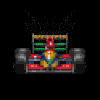SuperCNJ wrote: ↑23 May 2021, 22:29
The front
wing has no other supports at its free end and so is therefore purely cantilevered from the nose cone, whereas the
rear wing has at least two supports, at either end of the
wing making it far stiffer. Unless the front
wing is made ridiculously beefy, the front
wing is inherently going to flex more than the
rear wing. My guess is that all the cars on the grid will have quite a lot of flex in the front
wing, especially compared to the
rear wing which I think is more likely to be acceptable given the nature of the front
wing.
I think that this is why the new regs are stipulating that the wings MUST be mounted to the side of the nose-cone.
Just take a quick look at how the front wings are mounted, from a structural rigidity perspective, they are mostly a cantilever with a pivot point towards the
rear. Under load there will be a tendency for the
wing to pivot rearwards (losing AoA). There are some really extreme examples of this on the grid. All of the recent wings have been particularly
rear-loaded aerodynamically, which just increases the lever ratio around this virtual pivot. Basically the same as they are (all) doing with the
rear wings.
The question is if they are passing whatever load tests the FIA are using, how do you determine what is “taking the piss” and what is “acceptable”; because neither is within the ‘spirit of the rules’ which calls for bodywork to be “rigid with reference to the spring platform of the car”?
Perspective - Understanding that sometimes the truths we cling to depend greatly on our own point of view.


